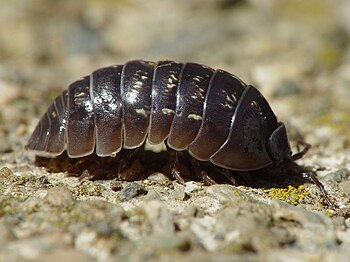Wikijunior:Bugs/Woodlouse

Woodlice are known by many names including pill bug, armadillo bug, potato bug, and roly-poly. They are crustaceans like crabs, or shrimp, but they live on land. There are more than 3000 known species.
What does it look like?
[edit | edit source]Woodlice are arthropods. Arthropods have segmented bodies and jointed limbs. There are about 3,000 different species. They are gray or brown, depending on the species and where they live.
Woodlice are crustaceans that live on land instead of in water. Crustaceans have a hard outer shell (exoskeleton). Woodlice are flat and oval with many flexible segments. They have other names such as sow bugs, pill bugs, doodlebugs, roly polies, and slaters.
Woodlice have 7 pair of legs adapted for crawling. They are between ¼ and about 7/8 inches long. In the tropics, they can be 2-5/8 inches or more in length.
The Common Shiny Woodlouse is smooth. It has scattered yellow spots on its back and bright spots along the edges. The last segment of the body has orange spots.
The Striped Woodlouse is shiny with a dark mid-line and dark head. The Common Pill Woodlouse has a tail shield (telson) that can be rounded or triangular in shape.
Woodlice have several different forms. Runners have large eyes and long legs. Rollers have many segments and can roll into a ball. Clingers have edges that press down on flat surfaces.
Where does it live?
[edit | edit source]Woodlice are found throughout the world in a variety of habitats. Some are found on rocky shores and breakwaters. They do not live in deserts or at the poles.
Woodlice live in gardens, forests, deserts, and jungles. They are found in cool, dark, moist places, like caves. They need shelter from daytime dryness and heat. Woodlice that live in desert regions forage at night when it is cooler.
Most Woodlice live in soil and layers of litter. Some species are arboreal, living in trees. Woodlice in the tropical rain forests live in tree tops and on bark, leaves and branches.
Pill Woodlice live on the forest floor or under the bark of dead trees. They are found in calcium-rich soil of abandoned fields. They use calcium to build an exoskeleton. They are found in woodwork, roofs, ceilings, and cellars.
Carr Slaters live in wet environments. Rock Slaters are found on ocean beaches. They are amphibious, living on land and in water.
What does it eat?
[edit | edit source]Woodlice feed mostly on dead or decaying plant matter. They eat leaf litter, dung, decayed wood, rotting fruit, and fungi. They sometimes eat soft, moist plant parts.
Woodlice in citrus orchards feed on larva and pupae of fruit flies. Sometimes, they eat other woodlice.
Rock Slaters feed at night, mainly on seaweed. Woodlice in dry regions feed at night so they do not lose moisture.

What stages of metamorphosis does it go through?
[edit | edit source]Woodlice undergo simple metamorphosis. There are 4 main life stages, egg, manca, juvenile, and adult. They breed in springtime.
Females lay 25-35 eggs. Eggs are carried inside a brood pouch where they develop and hatch. They hatch in a few days and remain in the brood pouch for a few months. They leave when they are able to survive on their own.
Newborn Woodlice are very similar to adults. They shed their exoskeleton several times as they mature. They lose the back half of the shell first, then the front half a few days later.
Most woodlice have a lifespan of about 2 years. Some can live to be 4 years old.
How does it defend itself?
[edit | edit source]Woodlice predators include toads, spiders, centipedes, and wasps. Others are mammals, birds, lizards, scorpions, and beetles.
To protect themselves, some Woodlice curl into a ball. When curled up, the legs and feelers are protected under the outer covering.
Carr Slaters and Striped Woodlice escape predators by running very fast. They hide in small pools of water.
Woodlice change their spot colors to match their surroundings. This helps hide them from predators.
What special behavior does it exhibit?
[edit | edit source]Some Woodlice called True Pill Bugs have an arched body and a short tail (uropod) so they can roll into a ball for protection.
Some species can only live only in hot greenhouses.
How does this bug affect people?
[edit | edit source]They are beneficial because they play a role in decomposition in the soil. They help make soil richer by mixing nutrients into it.
If Woodlice populations become too large they can be pests.
References
[edit | edit source]https://bugguide.net/node/view/15976
https://www.csub.edu/~ddodenhoff/Bio100/literature/paper6.pdf
